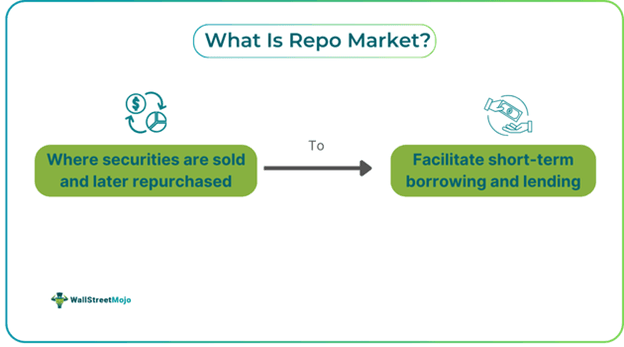Table of Contents
What Is Repo Market?
A repo market is a marketplace that enables central banks to implement monetary policies efficiently under normal market conditions. The market provides short-term cash loans backed by government securities. It allows swift actions by central banks to fulfill their duties as lenders of last resort in times of market stress.

The market is critical for the efficient functioning of all financial markets. These markets provide short-term funding and pave the way for a resilient and strong money market. A properly functioning market of repo rates facilitates short-term investments and smooth central bank operations. It also ensures secondary debt market liquidity and economic well-being, among other things.
Key Takeaways
- The repo market facilitates repurchase agreements, in which short-term loans backed by government securities are given out.
- Under the agreement, parties sell securities and repurchase them after a certain period to meet their needs.
- The market participants include central banks, broker-dealers, hedge funds, and mutual funds.
- It helps control the money supply, control inflation, and provide cheap capital, especially for short-term needs.
- It is essential as it facilitates the implementation of monetary policy, enhances liquidity, prevents settlement failures, and aids in stabilizing the economy.
Repo Market Explained
The repo market is a market for repurchase agreements (referred to as repos for short). Repo rates are facilities given out by economies where short-term loans (often overnight) are availed with the backing of government securities as collateral. Repos are exercised for various reasons, such as controlling the money supply and inflationary pressures and raising cheap short-term capital.
In repurchase agreements, one party agrees to sell securities to another party and later buy them back after a specific period. The selling party repurchases the securities at a higher price and pays interest to borrowers. Here, the securities issued by the government serve as collateral. The difference between the initial price of the securities and their repurchase price is the interest that is paid; this amount of interest is also known as the repo rate.
Governments often use the market to implement monetary policies and buy securities when cash is needed to inject into their economy and enhance the economy's stability. Participants in the market include sellers like hedge funds, broker-dealers, insurance companies, and buyers such as corporations and mutual funds in the money market. These are participants apart from the central banks and governments. The participants find financing options through the market. Hence, disruptions in the repo market can affect banks' lending conditions and market liquidity.
The Hargreaves Lansdown provides access to a range of investment products and services for UK investors.
Examples
Let us look at some of the examples to understand the concept better.
Example #1
Suppose XYZ, a mutual fund company, faces a cash crunch and decides to participate in the overnight repo market to meet its short-term obligations. To secure liquidity, XYZ enters into a repurchase agreement with ABC Ltd., a large investment company. In this arrangement, XYZ sells its government-backed securities to ABC with the agreement to repurchase them the next day.
This transaction provides XYZ with a short-term loan using the securities as collateral. The overnight repo helps XYZ access quick cash while ensuring the asset security of the government-backed securities. It will be repurchased the following day, typically with a small interest payment included.
Example #2
The U.S. repo market has seen a sharp rise in overnight repurchase agreements, creating challenges for banks acting as intermediaries. With a market size of $4 trillion, hedge funds and financial firms depend on these short-term borrowing arrangements to finance daily trades. Any disruptions could trigger the liquidation of securities, as banks have become more reluctant to lend, especially at the end of quarters, causing repo rate spikes.
Investor trading strategies, such as "basis trades," have contributed to the surge in repo volume. While funding conditions have temporarily stabilized, the market faces the risk of future volatility due to systemic issues.
Economic Impact
Some of the points that highlight the impacts of the market are given below.
- Short-term funding: The markets provide short-term funding opportunities secured by high-quality assets. These loans are cheaper and hence lower the cost of availing financial services.
- Aids in money market resilience: Repo market resilience helps mitigate systematic risks. It provides solidly backed-up short-term funds, allowing investors and traders to temporarily convert their assets into cash in a stressed market.
- Facilitation of central bank operations: The market facilitates the implementation of policies. It helps banks redistribute liquidity to banking and non-banking institutions. Additionally, it facilitates the control of economic conditions through repurchase agreements.
- Financing and covering investors: Hedge funds, which are institutional investors, use the market to borrow cash and leverage investment strategies. This enhances the price discovery mechanism and prevents asset price bubbles. Investors also use them to hedge against market fluctuations. They also help international investments without the exposure of currency risks.
- Ensures secondary debt market liquidity: It allows investors to sell securities on demand and provides hedging options, too. Since issuers incur fewer borrowing costs, it reduces investors' risk and helps maintain market liquidity.
- Prevention of settlement failures: The loan arrangements ensure securities delivery on time, enhancing investor confidence. Intermediaries are also allowed to borrow securities to manage delivery obligations, which helps prevent disruptions in trading and cascading failures. It also helps stabilize the economy.
Disclosure: This article contains affiliate links. If you sign up through these links, we may earn a small commission at no extra cost to you.

